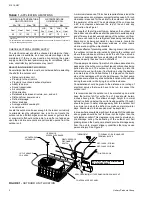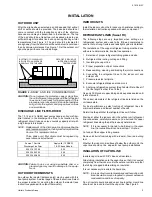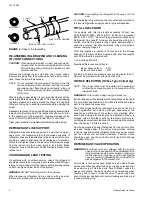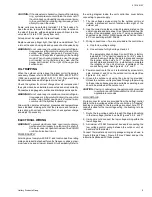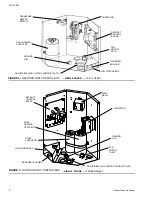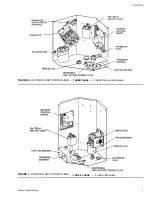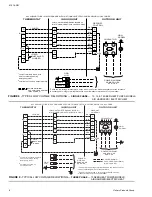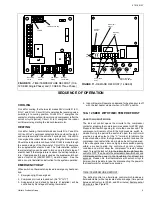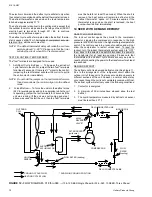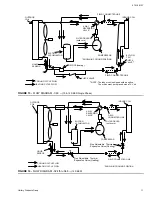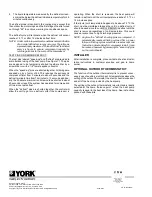
OUTDOOR UNIT
After the site has been selected, a solid base pad that will not
shift or settle should be provided. The base pad should not
come in contact with the foundation or side of the structure
because sound may be transmitted to the residence. The top
of the pad should be at least two inches above grade to give
sufficient height for defrost ice build up during freezing winter
temperatures. See Figure 2. The pad should be located far
enough away from the structure so the outdoor unit is not closer
than its minimum distances. See Figure 1. Set the outdoor unit
upon the pad with care to avoid damage.
CAUTION: Do not remove the protective caps or plugs from
the unit refrigerant connections until the refrigerant
lines are run and ready for final connection. If this
procedure is not observed, dirt and other particles
will get into the system and plug various orifices
and small tubes.
DISCHARGE LINE FILTER-DRIER
The 10, 12 and 14 SEER heat pumps have a solid core filter-
drier located in the discharge line. Due to its location in the
refrigerant circuit it uses a unique oversize capacity drier with
a high temperature binder.
NOTE: Replacement of the discharge line drier must be the
exact same as marked on the original factory drier. See
Source 1 for replacement drier.
Three phase unit filter dryers must be replaced by
exact same as listed below:
CAUTION: Failure to do so or using a substitute drier or a
granular type may result in damage to the equip-
ment.
OUTDOOR THERMOSTATS
An outdoor thermostat (balance point) may be used with this
heat pump system. See last page of these instructions. Select
the proper location for mounting the outdoor thermostat (see
instructions packed with outdoor thermostat).
INDOOR UNITS
Install the indoor coil on the furnace or air handler according to
the installation instructions packed with each component.
REFRIGERANT LINES (Sweat Fit)
The following steps are very important when setting up a
refrigeration system and need to be followed completely to
ensure that a strong, flexible and leak tight system is obtained.
The installation of the copper refrigerant tubing must be done
with care to obtain reliable, trouble-free operation.
1. Selection of proper refrigerant tubing grade and size
2. Refrigerant line routing, cutting and fitting
3. Insulating the vapor line
4. Proper preparation of joint connections.
5. Reassembling, cleaning and brazing the joint connections
6. Connecting the refrigerant lines to the indoor coil and
outdoor unit.
7. Pressure leak test all joints.
8. Evacuate refrigerant lines and indoor coil
9. Charging refrigeration system (See Tabular Data Sheet if
the line length is other than 15 feet).
Use only ACR grade copper tubing and keep ends sealed until
joints are made.
The correct diameters of the refrigerant lines are listed on the
unit nameplate.
For best performance, select routing of refrigerant lines for
minimum distance and fewest number of bends.
Determine the path that the refrigerant lines will follow.
Starting at either the indoor coil or the outdoor unit refrigerant
line connections, carefully measure, cut, de-burr and fit copper
refrigerant lines along the path previously determined.
NOTE: If it is necessary for bends to be formed in the vapor
line, the radius should not be less than 12 inches.
Cut ends of the copper tubing square.
Remove all burrs from tubing with a reamer, file or de-burring
tool.
Whether the indoor coil is above of below the outdoor unit, the
vapor line should not be sloped for heat pump installations.
INSULATION OF VAPOR LINE
Insulate vapor line with 3/8" closed cell insulation.
Slide tubing insulation onto the vapor line so that it is covered
completely from the indoor coil to the outdoor unit. Be sure that
the tubing is capped before sliding on insulation.
It is not necessary to insulate the liquid line.
NOTE: In areas of extreme temperatures and humidity, addi-
tional insulation may be required to prevent excessive
condensation and loss of capacity.
Do not insulate liquid line and vapor line together. Liquid line
should not be in contact with the vapor line. See Figure 3.
BOTTOM OF COIL SHOULD
BE HIGER THAN AVERAGE
SNOWFALL FOR THE AREA
DEFROST ICE BUILD-UP
IN FREEZING WINTER
TEMPERATURE
FIGURE 2 - SNOW AND ICE CONSIDERATIONS
INSTALLATION
Source 1 Part No.
Discharge Line Drier
Apply with (10 SEER)
1 & 3 Phase Models:
026-11913-700
036
026-13486-700
048
026-13455-900
060
515.16-N3Y
Unitary Products Group
3


